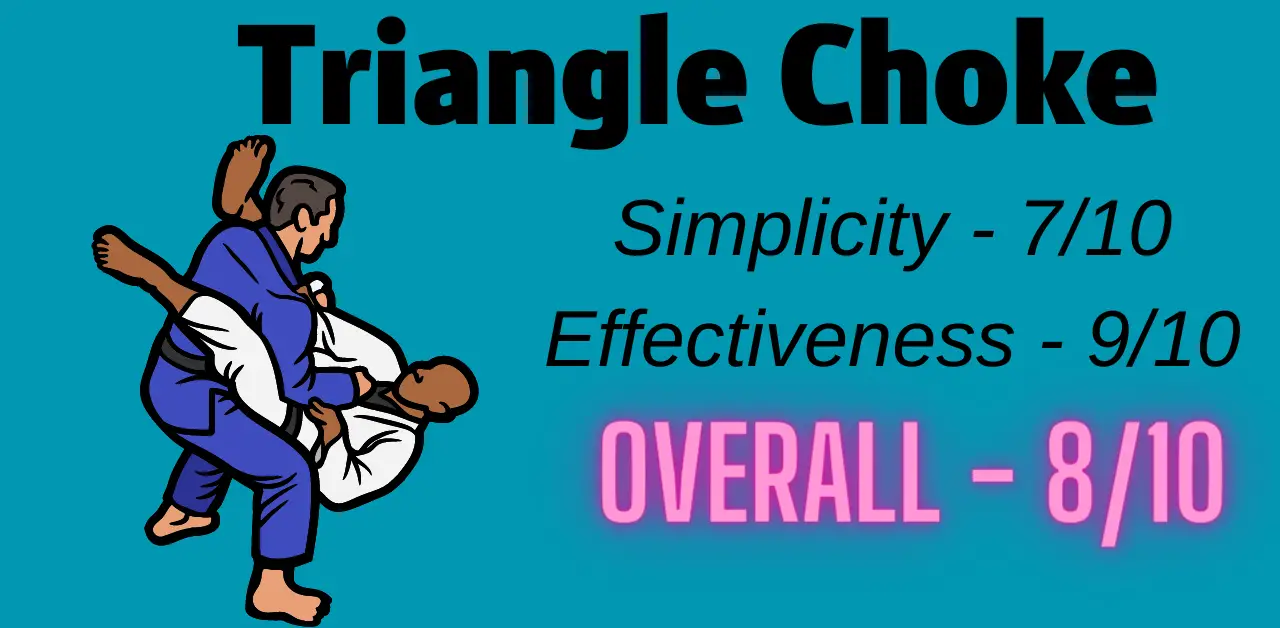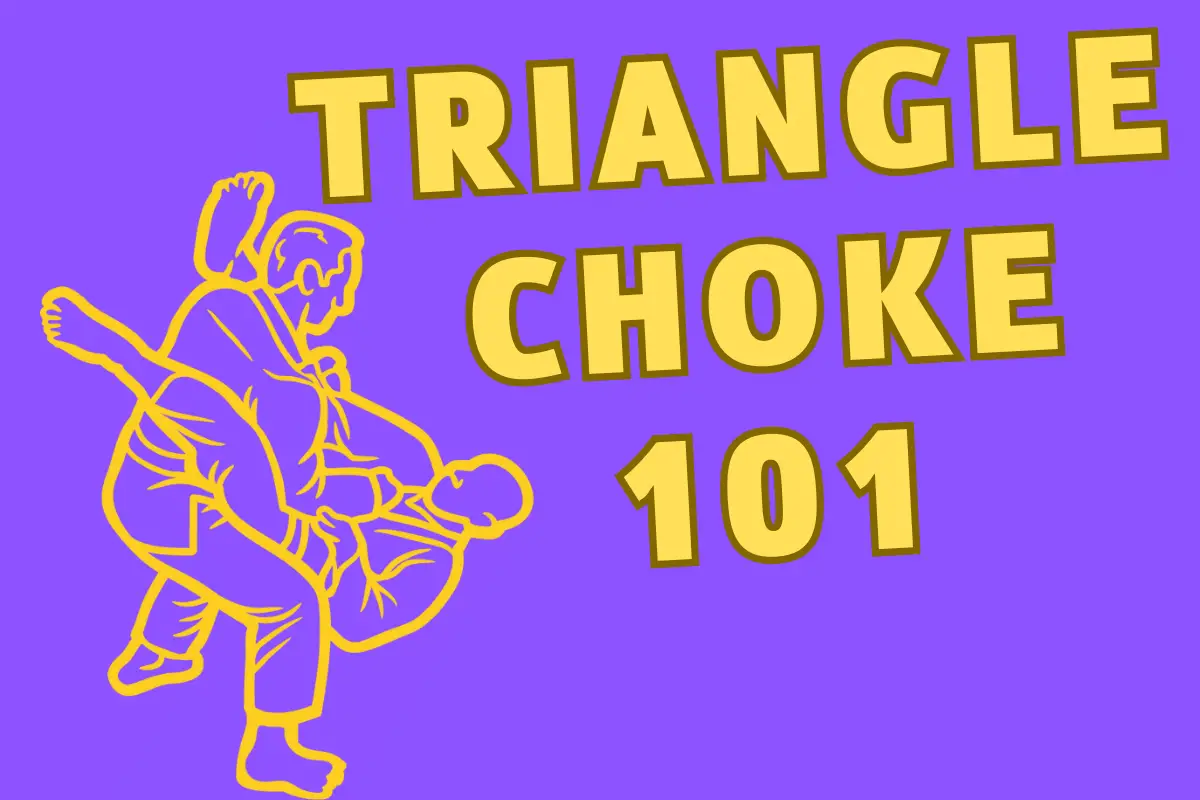The Triangle choke has to be one of Brazilian Jiu-Jitsu’s most influential, powerful, and effective chokes. Even non-grapplers are familiar with it, at least in its name. If you manage to land a Triangle, the opponent stands no chance.
This article will explain EVERYTHING about this beautiful submission, including the small details that prevent you from successfully submitting people with it. You’re likely making these minor mistakes that prevent you from being a complete grappler.
Let’s see how you can fix these mistakes and perform this choke correctly.
The Triangle choke is a practical and popular submission in Brazilian Jiu-Jitsu. It includes using your legs in a triangle shape and applying pressure around the opponent’s neck and arm. You can apply large amounts of pressure with your legs, as they’re your most powerful asset, and it’s effective because of that.
Before we dive into the article, I have more posts about other submissions and BJJ moves that I review. Eventually, I give each technique a ranking, so you can know what to focus on when starting your grappling journey.
For now, if you want to read more about the Armbar and what makes such an effective finishing submission, follow the link.
The following section will explain what the Triangle is and will briefly go over how you can start to perform it correctly and effectively.

What is the Triangle choke?
Brazilian Jiu-Jitsu teaches us many effective and practical techniques. Some of what it teaches will be less applicable to real fights. I chose the topic of this article because I wanted to spread the word about it since I’m confident it can help you become a more complete grappler.
The Triangle choke is a submission that utilizes having your legs in a triangle shape. Then, you apply pressure around the opponent’s neck and arm and force him to tap out. It’s so effective because it’s not as complicated to execute and can be deadly. That’s why many UFC fighters implement it into their skill sets.
The Triangle choke allows you to win many street fights, as the average person on the street doesn’t know basic defensive moves against grappling.
As a result, you’ll find it easy, for the most part, to choke someone out in a real fight, as the person you’re against likely only knows how to punch.
The Triangle is as widespread as it is because it’s a basic BJJ move many MMA fighters use. As a result, more people want to master it, as they understand its effectiveness level.
We’ll discuss how to perform the Triangle choke in the next section. Likewise, the following 3 parts of this article will cover everything about how to execute the Triangle and its many variations. Stay tuned for that.
How to perform the Triangle choke
The Triangle choke is one of the most effective techniques in the world of Jiu-Jitsu. All grapplers are familiar with it because you want to ensure they don’t get caught off-guard and end up losing a roll or a competition. Here’s how you perform it:
To perform the Triangle choke, you must first be in a closed guard position. Then, come under the opponent’s hands and force him toward you. Next, get a lower hook. Raise your legs in a triangle shape. Insert your legs around his neck while trapping his arm. Apply pressure and wait for the tap out.
Now, this is how you perform it from the guard position. We’ll also discuss many variations you can use, such as while in mount or side control.
Knowing them is critical in becoming a better grappler for offense and defense.
What I mean by that is if you want to learn how to escape the Triangle choke from, let’s say, the mount, you must first understand how it works offensively. Only then will you become capable of defending against it.
Before we dive in, if you want to learn an extremely effective BJJ submission and become a better grappler, follow the link to read about the Straight Arm Lock submission and how you can learn it today!
A step-by-step guide to the Triangle choke
In the last section, we discussed performing the Triangle choke from the guard position. First, however, I want to discuss how you can do so from the mount position.
Likewise, I’ll present the instructions in a different format for those who might prefer it that way.
The Triangle from the mount can be more difficult to understand. However, it will get more intuitive with more experience and practice. Thus, don’t get overwhelmed when you read it for the first time.
- Start in the mount position: Begin in the mount position, with your opponent on their back and you on top of them, straddling their chest with your knees.
- Control your opponent’s arm: Use your left hand to control your opponent’s left arm. Grab their wrist and pull their arm across their body towards your right side.
- Secure the triangle: While maintaining control of your opponent’s left arm, slide your right leg over their neck and place your right foot on your left knee. Your left leg should be draped over your opponent’s chest. The space between your legs forms a triangle. Make sure the triangle is tight around your opponent’s neck.
- Adjust your position: With the Triangle secured, use your right foot to push your opponent’s head down and to the right. This will create additional pressure on their neck and make it harder for them to escape.
- Apply the choke: With the Triangle and your opponent’s arm secured, apply pressure by squeezing your legs together and pulling down on their head with your left hand. This will cause your opponent to tap out or lose consciousness.
Variations of the Triangle choke
You should have a basic understanding of the Triangle choke if you have read everything thus far. However, we have yet to cover its fundamental variations. Although we briefly reviewed the Triangle from the mount and closed guard, it’ll be best to expand on these topics.
I want you to understand the small mistakes that most beginners make. These mistakes are the ones that prevent them from winning more BJJ fights.
So, this is what this section will focus on; fixing the small mistakes that most novice grapplers make when they perform the Triangle choke.
If you want to learn about another choke highly effective choke, follow the link to read a complete BJJ guide to the rear naked choke!
Triangle choke from closed guard
The Triangle choke from the closed guard position is the most popular, as it’s the easiest to understand. As you previously saw, this submission from the mount position is more difficult.
As a result, more people are attracted to the Triangle from the guard position. Let’s see how you can perform it yourself:
- Be in the guard position
- Get your opponent’s hands on the ground
- Make a lower hook
- Raise your legs in a triangle shape
- Trap his arm and head
- Pivot yourself to maximize pressure on the neck
- Wait for the tap
This is perhaps one of the most effective BJJ techniques. It’s also the variation you learn first, as it’s the easiest to understand. I recommend learning it as soon as possible.
Triangle choke from mount
Now, let’s go over the Triangle choke from the mount position. We’ve already reviewed it, so I’ll keep it simple and short.
- Start in the mount position
- Slide your knee under the opponent’s arm
- Secure the head
- Grab the wrist
- Put your foot on the biceps
- Put one leg over the neck
- Insert the other leg
- Make a triangle shape
- Lock your legs
- Apply pressure and wait for the tap
This variation differs from the one we’ve seen in the previous section. I have seen this variation many times in my life. But, the primary source I learned this from is the Gracie YouTube channel.
I recommend watching their work if you want to learn more variations of BJJ submissions. But, likewise, they explain everything perfectly well, so I encourage you to follow their work.
Triangle choke from side control
The Triangle choke from side control is the least popular one, from my experience. It’s also more challenging to execute, as it’s somewhat unintuitive.
However, the more you see happening in front of your eyes, the more you’ll get used to the motion it offers. Thus, you’ll better understand the Triangle from side control the more you invest in training.
Here’s how to perform the Triangle choke when you have side control:
- Start with side control
- Isolate the opponent’s arm
- Stick the other arm on the belly
- Shift your weight to the opponent’s head
- Lift the head
- Go around in one motion with your leg and around the neck
- Bring your other knee to your foot
- Lock the Triangle
- Apply pressure and wait for the tap
You have to be careful when you practice the Triangle with someone. It can be easy to forget that your opponent will get no air until you unlock the submission. So, just be careful and be aware of the opponent’s situation.
One mistake most people make with the side Triangle is that they try to lock it too early. Don’t do that. Instead, bring your other knee to your one foot before locking the submission.
And that’s it. You can now learn and perform the Triangle from the guard, mount, and side control positions. Good luck!
If you want to learn how to perform the Kimura, I wrote a complete guide that breaks the submission down to help you learn and master the Kimura quickly. Give it a read if that interests you by following the first link.
How to escape the Triangle choke
To escape the Triangle choke, you must move your head backward, so the opponent will have no chance of locking the Triangle. Of course, there are other ways you can escape it. But, the primary guideline is to grab the opponent’s hips and pull yourself backward while sticking your head to his belly.
The best way you can learn relevant escape routes to the Triangle choke is by putting yourself out there and practicing the submission on someone else.
Surprisingly enough, you’ll be able to learn basic defensive moves by using the offensive submission itself.
But again, you can also use the advice I gave you in this article. So here are other ways you can use to escape the Triangle choke.
When should I use the Triangle choke?
You should use the Triangle choke when in the mount, guard, or side control positions. First, you can tap the waters by faking going for the Triangle, waiting for the opponent’s response. Then, remain dynamic and act according to the response you get. You’ll be more effective this way.
You can really go for the Triangle choke whenever you want, as long as you don’t force yourself into an uncomfortable position.
If you have a hard time passing people’s guard, you should read another article I wrote that teaches how to pass anyone’s guard using the Toreando pass. Follow the link to learn more!
Is the Triangle choke the most effective technique?
The Triangle choke is one of the most effective techniques taught in martial arts, such as BJJ, Judo, and MMA. Thousands of professional fights have ended, with one party inflicting this choke on the other. Learning it is also uncomplicated, making it more approachable to novice trainees.
It’s all relative when we compare effectiveness. We can always go about ranking each technique for its simplicity and effectiveness. However, we can never honestly know what submission is most effective.
Why is the Triangle choke so popular?
The Triangle choke is popular because it’s one of the first submissions BJJ trainees learn. It’s also known for its effectiveness, even in self-defense and street fights. You will surprise your opponent if one doesn’t know how to defend against basic effective grappling moves.
That’s why it’s so popular. So many people know it, as they’re familiar with its effectiveness. As a result, they want to learn it too, which made a cycle that promoted this technique to everyone, even not BJJ practitioners.
How effective is the Triangle choke?
You’ll learn many submissions throughout your BJJ journey. You’ll also hear many opinions regarding which ones you should invest your effort into. Well, now it’s time you hear my opinion!
The Triangle choke is one of the most effective submissions in BJJ and MMA. It’s also fairly easy to execute, especially from the guard position. As a result, novice grapplers can use it to grab their first few wins, as they can start learning and mastering it from the moment they get their white belts.

The Triangle is so effective because it’s intuitive to learn. You can perform this submission in the mount or guard positions without much practice.
As a result, it’ll be one of the first ones you’ll learn since your coaches want you to start seeing results from the very first training session. That will keep you motivated to keep training.
If you want to learn another highly effective and straightforward BJJ technique, I wrote a complete guide to master the Wrist Lock. Give it a read to start bettering your BJJ skills by learning another submission.
Final words
Alright, you have gotten to the end of this article. First, I want to congratulate you for making it thus far. You are one of the few people who have read the entire piece.
This tells me you’re highly ambitious and that you want to learn BJJ as quickly as possible. Read the entire series of this BJJ submissions breakthrough by following the link at the end of this article.
Nonetheless, I hope you now know the basics of the Triangle choke. Although it might be hard to learn and relatively unintuitive, it’s worthwhile.
Learning it will teach many lessons about this beautiful, effective, practical, and applicable Brazilian Jiu-Jitsu martial art.
So this is the Triangle choke, one of the most effective techniques in BJJ. But it’s not the most powerful one. I wrote an article on the most effective BJJ techniques you must learn to call yourself a good grappler. So give it a read to learn these techniques and how to perform them.

